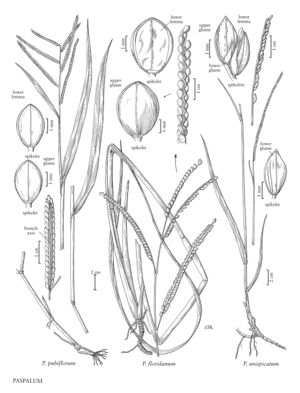Paspalum floridanum
Plants perennial; rhizomatous. Culms 80-210 cm, erect; nodes glabrous or pubescent. Sheaths glabrous or pubescent; ligules 1.2-3.3 mm; blades to 52 cm long, 3-18 mm wide, flat, glabrous or pubescent, usually densely pubescent behind the ligules. Panicles terminal, with 1-6 racemosely arranged branches; branches 3-17.9 cm, divergent to erect, terminating in a spikelet; branch axes 0.3-1.8 mm wide, glabrous, the margins scabrous. Spikelets 2.9-4.1 mm long, 1.9-3.1 mm wide, paired, imbricate, appressed to the branch axes, elliptic to suborbicular to orbicular, glabrous, stramineous. Lower glumes absent; upper glumes glabrous, 5-veined, margins entire; lower lemmas glabrous, lacking ribs over the veins, 3-veined, margins entire; upper florets golden brown. Caryopses 2.8 mm, amber. 2n = 120, 140, ca. 160-170.
Distribution
Md., Kans., Okla., Miss., Tex., La., Pa., Mo., Del., Ala., D.C., Tenn., N.C., S.C., Va., Ark., Ill., Ga., Ind., Ky., N.J., Fla., Ohio
Discussion
Paspalum floridanum grows along the edges of forests, flatwoods, and pinewoods and in open areas. It is a frequent component of dry-mesic soils in longleaf pine-oak-grass ecosystems, and is restricted to the eastern United States.
Selected References
None.
Lower Taxa
"decumbent" is not a number.
